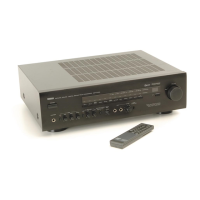
Do you have a question about the Yamaha DSP-E300 and is the answer not in the manual?
| Number of Channels | 5.1 |
|---|---|
| Sampling Frequency | 48 kHz |
| Dynamic Range | 96 dB |
| Input Sensitivity | 200 mV |
| Signal to Noise Ratio | 100 dB |
| Frequency Response | 20 Hz - 20 kHz |
| Audio Processing | Digital Signal Processing |
| Type | Processor |
Describes how the manual is organized and differences between models.
Explains warning symbols used in the manual.
Warns against exposing the appliance to rain or moisture.
Lists essential safety guidelines for operating the appliance.
Covers unpacking the DSP system and installing batteries in the remote control.
Provides guidance on using the remote control effectively.
Explains the core concept of DSP technology.
Details the principles behind Yamaha's Active Servo Technology.
Describes the features and benefits of Dolby Pro Logic Surround.
Discusses 4-channel vs. 6-channel setups.
Advises on the role and positioning of a center speaker.
Illustrates and labels the rear panel connections for the DSP-A700.
Details cartridge compartment, main speaker terminals, input/output jacks, and controls.
Describes video, tape, general input, and speaker output connections.
Covers rear speaker terminals, rear out jacks, and center speaker connections.
Explains connections for subwoofer and center channel outputs.
Describes power outlet types and usage.
Importance of setting the correct voltage.
Instructions for inserting the cartridge.
Guides on setting rear panel switches like MAIN LEVEL and FRONT MIX.
Provides instructions for positioning main, front, rear, and center speakers.
Visual guides for 6-channel and 4-channel speaker setups.
Emphasizes correct channel and polarity connection.
Details how to connect the AVS-700 selector.
Specific connections for the DSP-A700 with AVS-700.
Specific connections for the DSP-E300 with AVS-700.
How to connect using PRE OUT and MAIN IN terminals.
How to connect when PRE OUT/MAIN IN are not available.
Instructions for connecting a preamplifier.
Details how to connect front, rear, and center effect speakers.
Instructions for connecting a subwoofer for enhanced bass.
Explains how to connect for displaying information on the monitor.
Identifies and describes front panel controls for DSP-A700.
Covers effect level, Dolby Pro Logic test/level, center mode, and input balance controls.
Describes microphone input and overall volume adjustment.
Explains the functions of the remote control unit keys.
Details source select keys, function keys, and parameter editing.
Explains the functions of the DSP-E300 remote control unit.
Steps before making volume adjustments.
Guides on setting master volume and other levels for optimal listening.
Procedure to optimize Dolby Pro Logic decoder performance.
Procedure for balancing speaker levels using test signals.
Adjusting DSP front, rear, and center speaker levels.
Calibrating center and rear speaker volumes.
How to select audio sources.
Overview of available DSP programs.
How to choose DSP programs using front panel or remote.
How to select subprograms within DSP programs.
How to mute effect speakers for comparison.
Brief descriptions of various DSP sound fields.
Describes CHURCH, ROCK CONCERT, and JAZZ CLUB programs.
Describes DISCO, STADIUM, and MOVIE programs.
Description of the Dolby Pro Logic Surround program.
How to display program info on the monitor.
How to program the remote to control other devices.
How to remove learned functions from the remote.
Introduction to customizing sound fields.
Explains the concept of sound fields and their elements.
How to adjust parameters like INIT DELAY and ROOM SIZE.
Explains the ROOM SIZE parameter.
Explains the INIT DELAY parameter.
Explains the REV TIME parameter.
Explains the DELAY parameter for Dolby Pro Logic.
Lists parameters for each DSP program.
Continues the table of DSP program parameters.
Lists common problems and their solutions.
Technical specifications for DSP-A700 and DSP-E300.
Illustrates the internal signal flow of the DSP system.